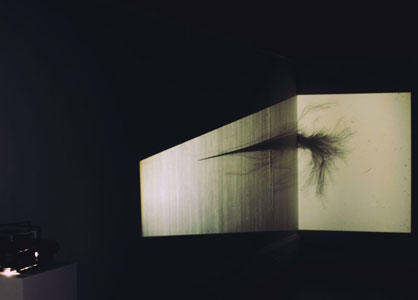EXHIBITIONS
Mortality: Death and the Imagination
05.07.13 - 16.08.13
Ian Breakwell, Felix Gonzalez-Torres, Douglas Gordon, Julian Opie, Cornelia Parker, Bob and Roberta Smith, Sam Taylor Wood.
There is no shortage of art, or indeed literature, which references or reflects upon death. As a way of dealing with the subject, strategies such as metaphor, as well as more oblique approaches, are often used as a route into this difficult subject.
Rather than using death as a blunt end-point, the exhibition turns its attention to mortality and the ways in which death appears (or is obscured) through being in the midst of life. Mortality: Death and the Imagination brings together the work of seven artists, their diverse responses to the theme help to reflect on the formation of perceptions and attitudes, as well as the ways in which death and dying are often kept at a convenient distance. Approaches to death can often provide an insight into cultural, social and political attitudes. Some areas require further scrutiny; science is often presented in terms of a set or series of potential answers, the voice of authenticity. Yet, despite offering a sophisticated array of medical solutions, it can also be a catalyst in the degradation of human life, particularly at the point of death.
The art works in Mortality: Death and the Imagination, all explore issues beyond the surface level; examining the degrees of separation between thought, experience and imagination. The works - in very different ways - all have a sense of consequence.
Douglas Gordon questions the very notion of scientific authenticity and its changing relationship with time (what appears as fact in one period, can become farce in another). Cornelia Parker explores our obsession with objects of potential significance and the fluid line between the momentous and the banal. Bob and Roberta Smith looks at mortality through more everyday means, the diary as a personal space in which to document and record. Julian Opie takes the iconography of the graveyard and transposes it to the space of the gallery. For Felix Gonzalez-Torres the idea of the placebo is developed through a work in which the viewer can take sweets from the floor of the gallery, reflecting on the ease with which we are often pacified by very little. Ian Breakwell's work seems to emerge from the midst of mortality, asking awkward questions as to how we approach our own existence and inevitable demise. For Sam Taylor-Wood, the process of life and death is presented through the continuous loop of the decaying still life.
The exhibition will be supported by a series of interdisciplinary talks, events and symposia that explore the works in relation to notions of well-being when confronted by our mortality. The exhibition will also be accompanied by a fully illustrated catalogue with essays by Steven Gartside and Clive Parkinson.
The exhibition is curated by Steven Gartside (Holden Gallery) and Clive Parkinson, Director of Arts for Health at Manchester Metropolitan University.
Find out more about the Arts for Health organisation www.artsforhealth.org
Follow the blog artsforhealthmmu.blogspot.co.uk




This event is one of 175 publically accessible events and exhibitions that took place in the UK and overseas throughout 2013 to celebrate the 175th anniversary of the Manchester School of Art.








